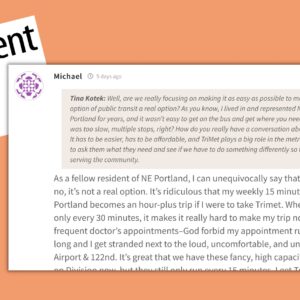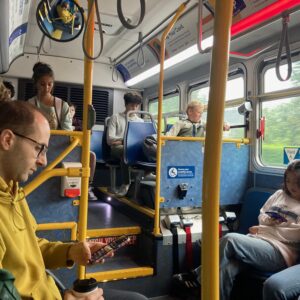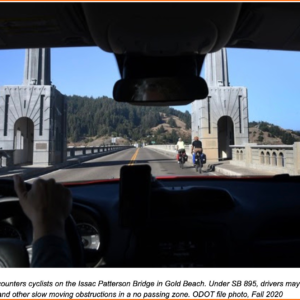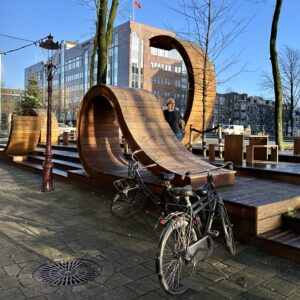
The Midnight Mystery Ride was 150 riders strong last month and is well into its second year. Bike Buddy programs are taking off. Last June, there were so many rides during the two and a half weeks of Pedalpalooza that the calendar had to double in size.
We have a wealth of organized group rides in Portland. And you’ll often see pairs or small groups riding around together, going places, or just out for a spin.
But even in Portland, the typical figure on a bike is riding solo.
“Why not have the best of both worlds—the thrill and health of cycling and the meditative feeling and social exposure of taking the bus?”
Why do the majority of folks bike alone? Maybe it’s because cycling alone comes naturally; whether you’re training for a race or headed to a picnic. I love a long, solo ride to clear my head and get my blood pumping.
But riding around alone can get a little dull, and I often find myself turning a ride across town into a race against the clock.
Riding a bike is largely parallel to—and a replacement for—driving a car. Like bicycles, cars are usually taken solo, driven competitively and fast, and give you feelings of freedom, excitement, and control. A friend pointed out that in a recent study probing Americans’ waning love of their automobiles, all the reasons people cited for loving their cars could also be applied to bikes. Great! But also a little disturbing. The car isn’t the only way of getting around, after all. Is it really the one we want to model ourselves after?
Sometimes I wish that bicycling were more like riding the bus.
Sure the bus is slow, but it gives you time to relax. And being in traffic is an entirely different story if you aren’t the one behind the wheel (or handlebars), thinking “I bet I can make this light” or “I would have made that light if that guy hadn’t cut me off.”
The bus makes you let go in a way that is sometimes frustrating but often liberating. On the bus, gazing out the window, you have time to take in details that are just a blur from a bike or a car.
And that’s to say nothing of the interior scene on the bus. Just as cycling is physically invigorating, it’s hard to find something more mentally and socially stimulating than taking the bus. You are surrounded by people, most of whom are strangers. You are brought into direct sensory contact with realities beyond your own. Riding the bus can be entertaining, appalling, engaging, disturbing, and heart-rending in ways that most of us experience very little in our daily lives.
A senior editor at the Wall Street Journal recently lashed out against transit advocates, gloating that Americans are “rugged individualists,” whereas bus travel will never catch on because it is “collectivist” in nature. If bicyclists are interested in cultural change beyond just the roads, we would be well-advised to take this comparison to heart.
Until we clear the roads of most car traffic or wise up and prioritize public transport to create fast, dedicated bus routes, I’m far happier to bike. The bus really has nothing on the health benefits, unlimited hours, and flexibility of bicycling.
But why not have the best of both worlds—the thrill and health of cycling and the meditative feeling and social exposure of taking the bus?
It’s easy. All you’ve got to do is slow down, pay attention to our surroundings and interact with others. Try a quick nod to passing motorists and a wave to fellow cyclists or even try stopping traffic for people in wheelchairs. We can choose to ride with other people, whether we already know them or just meet them along the way.
There’s a whole world waiting on the other side of your handlebars, so don’t be afraid to loosen your grip and let it all in.







Thanks for reading.
BikePortland has served this community with independent community journalism since 2005. We rely on subscriptions from readers like you to survive. Your financial support is vital in keeping this valuable resource alive and well.
Please subscribe today to strengthen and expand our work.
yeaH, Another great article, Elly.
slow is better than fast. If you see me out there riding, you will note that I am slowly going very fast.
For those who are interested in helping make triMet better(currently, TriMet is DECENT but could be superlative with some different thinking), We are having discussion group from 5 to 6pm on Wednesdays. Come and check it out – if you are intrested,
email me adamdoug2001@yahoo.com.
Team Midnight would like to make a slight correction to this very good article:
Midnight Mystery Rides are now well into the FOURTH year. Our debut ride was Valentine’s Day, 2003 with the inaugural Bicycle Be Mine ride.
GO! FIGHT! WIN!
~Team Midnight
Personally, I don’t like riding with lots of people or groups. The injuries are incredible. Perhaps someone should call AMR and get a statistic of injuries from from the Bridges Ride.
These idiots who don’t know what the word ’space’ means come rushing into yours and metal meets metal. So many cyclists out there with bad manners and not a clue.
Sorry, Elly – I have to disagree with you on this one, at least on some parts.
We’re not modelling ourselves after the car, the car has modelled itself on the bike. Bicycles pre-date the automobile in the United States by more than 20 years. The bicycle was introduced in the 1870s. What we view as the “modern” bicycle, with today’s general frame arrangement, has been around since the mid 1880s, and chain drive and pneumatic tires by 1892. In the 1890s, the cycling craze of the time spurred development of the first paved road system in the US. People enjoyed the freedom that cycling gave them – freedom to go where they want, when they want, not tied to the schedules and routes of the streetcars and trains.
In the 1920’s, cars became the new bikes. Early automobiles had similar tires and similar speeds to bicycles, and in the early years an equal number of mechanical problems. The hallmark of both forms of travel was a leisurely enjoyment of one’s surroundings in comfort at one’s own pace. Unfortunately, the desire for faster speeds and walling one’s self off from nature destroyed the car (and the airplane) experience and gave us the motoring purgatory we have today.
I ride the bus frequently, and it provides a good way to get into work when I don’t have the energy to ride 11 miles one way, or the weather is more than I am prepared to face that day. The bus, unlike the car or bike however, is a very passive experience. Cycling is active. Driving is active. Both require concentration, and focus an individual in the now, in the moment. For someone like me, who spends too much time in my own head either in the past or the future, that focus on the now is a welcome zen-like experience. One of the differences when I commute with others rather than alone is that I no longer notice my surroundings as much once I start getting involved in conversation. This isn’t necessarily a bad thing, just different. Sometimes I want to be aware, and sometimes I don’t.
Also, in riding the bus I *do* notice a lot more than I do in the car, but since I’m not a super-speed cyclist, I notice far more on the bike than I ever do on the bus. I’ve found shops, houses, whole streets I didn’t know existed, even when I’ve driven past them daily for years.
So, if you’re advocating a slower ride, I agree with you, but if not, then I have to say that I personally support any option that gives us an active, involved, aware experience while traveling – one that keeps us integrated with our surroundings / nature rather than “protecting” us from them.
Respectfully,
-Matt
BTW, if you’d like to see a REALLY cool commuting experience 😉 check out the top picture on this news story:
http://info.detnews.com/history/story/index.cfm?id=21&category=business
A 10-person bicycle from 1896. Now, THAT’s making cycling more like riding the bus!
-Matt
Here’s another way in which biking is like riding the bus: lots of stinky fumes
…and I don’t mean bus exhaust fumes
matt! let’s buy or build a 10 passenger bus bike. hell yeah, I am in for 1/10 ownership on that.